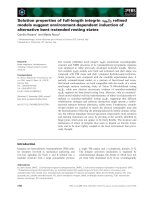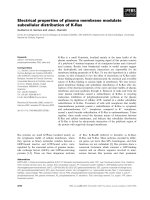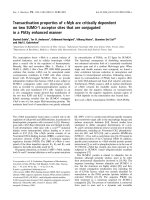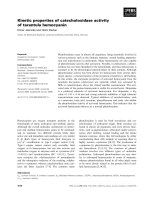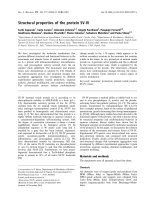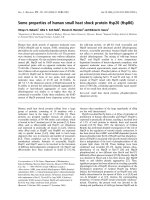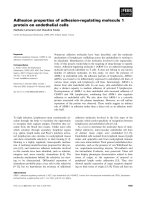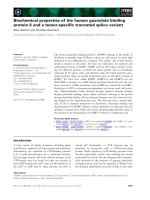báo cáo khoa học: "Genetic properties of North African Drosophila melanogaster and comparison with European and Afrotropical populations" pdf
Bạn đang xem bản rút gọn của tài liệu. Xem và tải ngay bản đầy đủ của tài liệu tại đây (855.42 KB, 15 trang )
Genetic
properties
of
North
African
Drosophila
melanogaster
and
comparison
with
European
and
Afrotropical
populations
P. CAPY
J.R. DAVID,
R.
ALLEMAND
P.
HYYTIA
J. ROUAULT
C.N.R.S.,
Laboratoire
de
Biologie et
Génétique
évolutives,
F
91190
Gif-sur- Yvette,
(·)
Laboratoire
de
Biologie
des
Populations,
Université
Claude
Bernard,
F
69622
Villeurbanne
Summary
Four
kinds
of
genetic
traits
(i.e.
allozyme
frequencies,
six
biometrical
characters,
ethanol
tolerance
and
oviposition
rhythm)
which
all
exhibit
latitudinal
clines,
were
measured
in
a
Tunisian
population.
Allozymes
and
morphology
were
also
studied
in
an
Egyptian
population.
The
data
were
compared
with
those
obtained
for
European
and
Afrotropical
flies
and
also
with
a
Seychellian
population
recently
introduced
in
this
archipelago.
In
all
cases,
the
morphology
was
studied
on
the
second
laboratory
gene-
ration
of
isofemale
lines.
North
African
flies
were
found
to be
very
close
to
European
flies
for
allozyme
frequencies
and
ethanol
tolerance,
but
very
close
to
Afrotropical
flies
for
ovariole
number,
wing
and
thorax
lengths.
For
other
traits
such
as
adult
weight,
number
of
sternopleural
chaetae
and
oviposition
rhythm,
the
North
African
flies
were
intermediate
to
those
from
Europe
and
Tropical
Africa
while
for
the
number
of
abdominal
chaetae,
the
North
African
flies
were
superior
to
both
of
the
other
populations.
Such
observations
demonstrate
that
significant
local
genetic
divergences
may
be
superimposed
to
the
general
tendency
of
the
latitudinal
cline.
In
spite
of
their
tropical
habitat,
the
Seychellian
flies
were
found
to
be
very
similar
to
those
living
in
a
temperate
country
and,
for
all
morphological
traits,
a
striking
similarity
was
observed
with
the
North
African
populations.
It
is,
however,
not
yet
possible
to
suggest
a
definitive
answer
for
the
origin
of
this
introduced
population.
Key
words :
Drosophila
melanogaster,
ecological
genetics,
geographic
races,
latitudinal
clines.
Résumé
Caractéristiques
génétiques
des
Drosophila
melanogaster
d’Afrique
du
Nord
et
comparaison
avec
les
populations
d Europe et
d Afrique
tropicale
Quatre
types
de
caractères
(fréquences
enzymatiques
de
7
locus,
6
caractères
biométriques,
la
tolé-
rance
à
l’éthanol
et
le
rythme
d’oviposition)
ont
été
mesurés
sur
une
population
tunisienne.
Les
fré-
quences
enzymatiques
et
les
caractères
morphologiques
ont
été
également
étudiés
dans
une
population
égyptienne.
Les
résultats
ont
été
comparés
aux
caractéristiques
de
mouches
d’Europe,
d’Afrique
équa-
toriale
et
également
à
celles
d’une
population
des
Seychelles
récemment
introduite
dans
cet
archipel.
Dans
tous
les
cas,
l’étude
biométrique
a
été
réalisée
sur
la
première
génération
de
laboratoire
de
lignées
isofemelles.
Les
mouches
nord
africaines
apparaissent
très
proches
des
mouches
Européennes
pour
les
fréquen-
ces
enzymatiques
et
la
tolérance
à
l’éthanol,
par
contre
elles
sont
aussi
très
proches
des
mouches
d’Afri-
que
équatoriale
pour
le
nombre
d’ovarioles,
les
longueurs
d’aile
et
le
thorax.
Pour
les
autres
caractères
tels
que
le
poids
des
adultes,
le
nombre
des
soies
sternopleurales
et
le
rythme
d’oviposition,
elles
sont
en
position
intermédiaire.
Finalement,
elles
présentent
des
valeurs
supérieures
à
celles
observées
en
Europe
et
en
Afrique
tropicale
pour
le
nombre
de
soies
abdominales.
De
telles
observations
démontrent
que
des
divergences
génétiques
locales
peuvent
s’ajouter
à
la
tendance
générale
des
clines
latitudinaux.
Malgré
leur
habitat
tropical,
les
mouches
des
Seychelles
sont
très
proches
de
celles
vivant
en
pays
tempérés
et
pour
tous
les
caractères
morphologiques
une
grande
analogie
est
observée
avec
les
popula-
tions
du
nord
de
l’Afrique.
Il
n’est,
cependant,
pas
encore
possible
de
préciser
définitivement
l’origine
de
cette
population.
Mots
clés :
Drosophila
melanogaster,
génétique
écologique,
races
géographiques,
clines
latitudinaux.
I.
Introduction
One
of
the
most
persuasive
pieces
of
evidence
that
natural
selection
is
acting
on
the
genetic
structure
of
wild
populations
is
the
occurrence
of
latitudinal
clines
which
are
known
in
a
great
number
of
species
(M
AYR
,
1963 ;
D
OBZHANSKY
,
1970).
However,
as
pointed
out
by
E
NDLER
(1977),
the
observation
of
such
clines
cannot
be
considered,
by
itself,
as
a
demonstration
of
selective
effects :
the
occurrence
of
stochastic
processes
is
always
difficult
to
exclude.
The
cosmopolitan
Drosophila
melanogaster,
which
is
one
of
the
only
two
Drosophila
species
able
to
proliferate
both
under
tropical
and
temperate
climates
(DAVID
and
T
SACAS
,
1981),
is
an
excellent
model
for
the
analysis
of
such
regular
geographic
variations.
For
the
moment,
latitudinal
clines
have been
described
for
various
morphological
traits
(T
ANTAWY
and
M
ALLAH
,
1961 ;
DAVID
and
BOCQUET,
1975a),
physiological
traits
(DAVID
and
B
OCQUET
,
1975b ;
A
LLEMAND
and
DAVID,
1976),
chromosomal
inversions
(M
ETTLER
et
al.,
1977)
and
allozyme
frequencies
(V
OELKER
et
al.,
1978 ;
OA
xESHOTT et
al.,
1981a,
b ;
DAVID,
1982 ;
S
INGH
et
l
ll.,
1982).
The
best
documented
information
presently
available
is
provided
by
the
analysis
of
allozyme
polymorphism
since
convergent
observations
have
been
obtained
on
different
continents
(North
America,
Europe,
equatorial
Africa,
East
Asia
and
Australia)
which
har-
bour
populations
with
very
different
histories
(DAVID
and
T
SACAS
,
1981).
As
argued
for
example
by
DAVID
and
BOCQU
ET
(1975a)
and
OAKESHOTT et
al.
(1981a,
b)
the
occurrence
of
parallel
clines
on
different
continents
is
a
strong
argument
in
favour
of
a
selective
pres-
sure.
However,
latitude
(and
related
environmental
climatic
variables)
never
explain
the
total
genetic
variability
between
populations.
Longitudinal
influences,
for
example,
may
be
observed
even
when
a
single
continent
is
considered
(O
AKESHOTT
et
al.,
1981a,
b ;
Loms
et
al. ,
1982).
Biochemical
polymorphism
is
a
remarkable
means
of
analysing
the
genetic
differentia-
tion
between
allopatric
populations
of
the
same
species.
Within
species
of
Drosophila,
allozyme
frequencies
are
generally
stable
(A
YALA
et
al.,
1974 ;
P
OWELL
,
1975 ;
N
EVO
,
1978).
This,
however,
may
be
interpreted
either
as
a
consequence
of
balancing
selection
or,
under
the
neutralist
theory,
by
the
occurence
of
some
genetic
exchange
between
populations
(K
IMURA
and
M
ARUYAMA
,
1971 ;
LE
WO
NTIN
,
1974 ;
K
IMUI
tA,
1979).
For
a
better
unders-
tanding
of
the
significance
of
allopatric
variations
in
D.
melanogaster,
it
now
appears
necessary
to
extend
the
analysis
to
populations
not
yet
studied
and
also
to
increase
the
number
of
genetically
variable
traits
which
are
measured
on
the
same
population.
We
present
here
a
study
of
north
African
flies
analysed
for
four
kinds
of
characters
which
all
exhibit
latitudinal
clines :
allozyme
frequencies,
morphology,
alcohol
tolerance
and
oviposition
rhythm.
These
populations
are
interesting
because
of
their
intermediate
position
between
tropical
Africa
(which
harbour
the
ancestral
populations
of
the
species)
and
Europe.
It
also
appeared
worthwhile
to
include
in
this
comparison
a
population
recently
introduced
to
the
Seychelles
(DAVID
and
C
APY
,
1982).
II.
Material
and
methods
The
major
aim
of
this
study
was
to
compare
north
African
populations
with
those
living
under
temperate
or
tropical
climates.
For
added
interest
we
have
also
included
in
the
comparison
information
on
a
population
recently
introduced
to
the
Seychelles
(DAVID
and
C
APY
,
1982).
The
populations
have
been
compared
for
a
total
of
15
different
genetic
traits,
namely
7
allozyme
loci,
6
different
morphological
characters,
plus
tolerance
to
etha-
nol
and
oviposition
rhythm,
which
we
will
refer
to
as
biometrical
traits.
A.
Populations
and
sampling
procedures
Two
north
African
populations
were
studied,
one
from
Alexandria
(Egypt)
and
one
from
Nasr’allah
(Tunisia).
Wild
collected
females
were
brought
to
the
laboratory
and
isola-
ted
in
single
vials
to
initiate
isofemale
lines.
These
lines
were
used
to
study
allozyme
variants
and
the
biometrical
traits.
In
the
case
of
the
Tunisian
population,
two
outbreeding
strains
were
also
made
by
mixing
15
different
lines.
An
alternative
sampling
procedure
was
used
to
examine
morphological
traits
in
the
north
African
population.
As
wild
living
fema-
les
are
often
inseminated
by
more
than
one
male
(M
ILKMAN
and
Z
EITLER
,
1974)
their
offs-
pring
are
a
mixture
of
full
and
half-sibs.
To
avoid
this
imprecision,
new
lines
were
founded
from
the
first
laboratory generation
by
crossing
a
virgin
female
of
a
line
with
a
male
of
another
line.
Two
of
the
initial
lines
were
used
to
initiate
only
one
new
line
so
that,
in
all
cases,
the
studied
flies
corresponded
to
the
second
generation
grown
in
the
laboratory.
This
procedure
produces
full-sib
individuals
in
each
family,
while
avoiding
the
possible
draw-
backs
of
inbreeding,
drift
or
laboratory
selection.
Information
on
the
populations
from
Europe
and
tropical
Africa
has
largely
been
taken
from
previously
published
studies
from
this
laboratory.
Data
for
the
allozyme
frequencies
have been
taken
from
previously
publis-
hed
reports
(DAVID,
1982 ;
S
INGH
et
al.,
1982).
Biometrical
data
too
have been
published
for
European
and
tropical
African
populations,
populations
founded
with
several
females
collected
in
many
localities.
However,
these
populations
had
been
kept
in
the
laboratory
for
several
months
or
even
years
prior
to
study.
We
wished
here
to
obtain
more
precise
information
on
natural
populations
living
in
these
countries
by
submitting
some
of
them
to
the
isofemale
line
analysis,
immediately
after
the
capture
of
wild
living
adults.
Two
French
populations,
Malauc6ne
and
Villeurbanne,
were
studied
in
that
way
and
also
two
Afrotropical
populations
from
Brazzaville
(Congo)
and Cotonou
(Benin).
Ethanol
tolerance
and
oviposition
rhythm
were
measured
on
mixed
strains
from
Congo
and
Villeurbanne
after
two
or
three
generations
in
the
laboratory.
For
the
Seychellian
population,
data
are
taken
from
a
previous
paper
(DAVID
and
C
APY
,
1982)
to
which
some
new
results
will
be
added
on
allozyme
frequencies
and
oviposi-
tion
rhythm.
B.
Characters
Enzymatic
polymorphism
was
studied
at
7
loci
using
starch
gel
electrophoresis.
Those
were
Adh,
Odh,
aGpdh,
Est-6,
Est-C,
G6pd
and
Pgm.
For
each
line
studied,
two
adult
flies
were
taken
at
random.
Six
different
morphological
traits
were
measured
as
described
by
DAVID
(1979).
The
offspring
of
each
couple
were
reared
at
25
°C
on
a
killed
yeast
medium
under
low
larval
density
and
10
individuals
were
measured
in
each
line.
Ovariole
number
was
determined
on
females
while
the
five
other
traits,
i.e.
fresh
weight,
thorax
and
wing
lengths,
sternopleural
and
abdominal
chaetae
numbers,
were
measured
on
males.
The
mean
of
each
line
was
taken
as
a
single
observation.
Ethanol
tolerance
was
determined
by
studying
adult
survival
in
the
presente
of
diffe-
rent
concentrations
of
alcohol
(see
D
AVID
et
al.,
1974).
The
daily
rhythm
of
oviposition
was
measured
as
described
by
A
LLEMAND
(1974).
Both
characters
were
measured
for
the
mixed
strains
of
Tunisian
flies,
and
on
the
mixed
strains
from
the
Congo
and
Villeurbanne
described
above.
III.
Results
A.
Allozyme
frequencies
Allelic
frequencies
at
7
polymorphic
loci
are
given
in
table
1
and
compared
with
results
from
French,
Afrotropical
and
Seychellian
populations.
For
the
Adh
locus,
a
high
fre-
quency
(0.95)
of
F
allele
is
observed
in
Tunisia,
as
it
is
in
France.
The
Egyptian
popula-
tion,
on
the
other
hand,
is
characterized
by
a
lower
frequency
of
this
allele.
For
all
the
other
loci,
the
two
north
African
populations
have
similar
frequencies
and
are
generally
close
to
the
west
European
sample.
The
main
differences
are
a
higher
frequency
of
aGpdh
s
and
the
absence
of
Est-C
S
allele
in
North
Africa.
The
generalized
genetic
distances
and
normalized
identities
(N
E
i,
1972)
are
given
in
table
2.
The
Egyptian
population,
for
which
only
5
loci
were
studied,
was
not
included
in
this
calculation.
The
four
groups
here
compared
may
be
distributed
in
two
classes :
Euro-
pean,
Tunisian
and
Seychellian
populations
are
very
close
(D
<
0.1)
while
Afrotropical
populations
are
notably
separate
from
the
three
others
(D
>
0.3).
B.
Biometrical
traits
For
three
geographic
origins
(France,
tropical
Africa
and
North
Africa),
two
popula-
tions
were
studied
with
the
isofemale
lines
technique.
The
average
values
for
the
6
mea-
sured
traits
are
given
in
table
3
and
comparisons
between
the
two
populations
of
each
geo-
graphic
group
are
done
by
a
t test.
Among
18
comparisons,
8
are
significant.
The
two
Afrotropical
populations
are
the
most
different
while
the
two
north
African
are
the
most
similar.
The
best
discriminative
trait
is
wing
length
while
the
most
stable
within
a
geogra-
phic
area
is
the
number
of abdominal
chaetae.
Table
3
also
allows
a
comparison
of
the three
geographic
groups.
For
the
various
traits,
the
greatest
difference
is
generally
observed
between
European
and
Afrotropical
!’
-
!!^f;r·r;na
nrevious
conclusions
based
on
the
analysis
of
many
laboratory
strains
(D
AVID
et
al.,
1977).
In
all
cases,
values
measured
in
European
populations
are
much
hig-
her
than
in
the
tropics.
North
African
populations
often
occupy
an
intermediate
posi-
tion
(weight,
wing
and
thorax
lengths,
sternopleural
chaetae).
They
are
however
superior
to
European
flies
for
the
number
of
abdominal
chaetae
while
they
are
almost
identical
to
tropical
flies
for
the
ovariole
number.
It
appeared
therefore
necessary
to
combine
the
different
traits
in
a
more
general
com-
parison
and
the
results
of
two
different
techniques
are
presented
here.
The
first
method
is
to
consider
the
«
biometrical
profiles
»
(L
EFEBVRE
,
1978 ;
C
APY
,
1982)
of
the
seven
populations.
The
means
and
variances
of
the
various
traits
are
very
dif-
ferent
so
that
an
homogenization
of
scale
is
necessary.
In
each
case
a
transformation
was
done
so
that
the
general
mean
becomes
0
and
the
variance
1
(standardized
variable).
After
that,
the
position
of
the
mean
of
each
population
is
shown
graphically
and
the
values
for
different
traits
in
the
same
population
are
joined
by
a
line
so
that
a
profile
is
visualized
(fig. 1).
We
see
that
the
two
French
populations
are
very
similar
and
always
above
the
zero
line
while
the
two
Afrotropical
populations,
although
more
distant,
are
always
below
the
zero
line.
The
two
north
African
populations
are
very
close :
they
are
above
the
zero
for
the
first
three
traits
and
below
for
the
last
three.
The
Seychellian
population
exhibit
a
pro-
file
similar
to
those
of
north
African
flies.
For
a
more
accurate
comparison
of
two
profiles,
two
properties
must
be
considered :
first
the
overall
distance ;
second
the
parallelism
of
the
lines.
To
estimate
the
distance,
we
used
a
very
simple,
empirical
formula,
as
follows :
where
Xi
and
Yi
are
the
mean
values
of
trait
i
in
populations
X
and
Y,
and
n
is
the
num-
ber
of
traits.
The
parallelism
of
two
profiles
was
estimated
by
the
coefficient
of
correlation
r.
The
values
of
these
two
parameters
for
the
21
possible
comparisons
are
given
in
table
4.
of
these
data
shows
that
they
are
not
distributed
at
random.
A
regular
pattern
can
be
observed,
allowing
the
calculation
of
the
average
values
given
in
table
5.
Distances
between
populations
of
the
same
geographic
origin
are
always
low
(m
=
2.4)
while
distances
between
European
and
Afrotropical
flies
are
high
(m
=
25.2).
North
Afri-
can
populations
occupy
an
intermediate
position
between
these
two
groups
from
which
they
are
equidistant
(11.5
and
11.4).
If
we
now
consider
the
Seychellian
population
(table
4)
we
see
that
it
is
very
close
to
north
African
flies
and
most
distant
from
the
French
ones.
Correlation
coefficients
are
highly
variable,
ranging
from -
0.987
to
0.981.
However,
a
regular
pattern
is
also
observed
(table
5).
Between
populations
of
the
same
origin,
a
posi-
tive
correlation
is
observed
(r
=
0.66).
North
African
populations,
on
the
other
hand,
are
negatively
correlated
both
to
European
and
Afrotropical
ones.
An
unexpected
result
is
the
positive
correlation
between
the
most
distant
populations
from
Europe
and
tropical
Africa.
For
the
moment,
it
seems
premature
to
suggest
an
explanation
to
these
observations
and
also
to
the
fact
that
no
r
values
are
close
to
zero
(table
4).
Looking
at
Seychellian
flies,
we
again
find
that
they
are
very
close
to
the
north
African
populations.
Both
for
the
distance
and
the
correlations
between
biometrical
profiles,
Sey-
chellian
flies
could
be
incorporated
to
the
north
African
group
without
any
significant
modification
of
the
average
values
given
in
table
5.
Another
way
of
comparing
the
7
populations
is
to
use
a
discriminant
analysis.
The
results
shown
in
figure
2
lead
to
a
similar
conclusion :
the
populations
are
distributed
into
three
groups.
The
first
axis,
for
which
the
main
variables
are
thorax
and
wing
lengths
and
ovarioles
number,
separates
European
populations
from
the
others.
The
second
axis
with
weight
and
abdominal
chaetea
number
as
preponderant
variables,
discriminates
Afrotropi-
cal
and
north
African
populations.
Seychellian
flies
are
superimposed
to
this
last
group.
C.
Ethanol
tolerance
Survival
curves
of
adults
after
two
days
of
treatment
with
various
concentrations
of
ethanol
are
given
in
figure
3.
These
curves
show
the
high
sensitivity
of
Afrotropical
flies
(lethal
concentration
50
=
6.5
%)
and
the
high
tolerance
of
European
and
Seychellian
flies
(L.C.
50 of
17.0
and
16.7
%
respectively)
as
already
described
(DAVID
and
C
APY
,
1982).
Two
measurements
were
done
on
mixed
strains
of
Tunisian
flies.
For
the
L.C.
50,
the
values
were
found
to
be
almost
identical
to
those
of
European
flies
(16.6
and
16.7
%).
However,
the
mortality
curves
exhibit
a
smoother
slope,
suggesting
a
greater
variability
bet-
ween
individuals.
More
specially
we
see
that
about
30
%
of
the
flies
were
killed
by
a
relati-
vely
low
concentration
of
8
%
ethanol.
This
observation
was
confirmed
in
two
other
repeats
(not
shown).
The
occurrence
of
a
great
variability
of
ethanol
tolerance
between
sympatric
flies
seems
a
specific
property
of
the
Tunisian
population.
D.
Daily
oviposition
rhythm
The
average
oviposition
curves,
under
a
LD
12.12
regime,
are
given
in
figure
4.
In
all
cases,
we
observe
an
oviposition
peak
at
the
beginning
of
the
scotophase
which
is
typical
of
D.
melanogaster.
The
data
also
confirm
that
the
height
of
the
peak
is
much
more
important
in
Afrotropical
than
in
European
populations
(A
LLEMAND
and
DAVID,
1976).
The
Tunisian
population
exhibits
a
peak
which
is
a
little
higher
than
in
French
popu-
lations,
as
could
be
expected
from
the
latitudinal
cline
previously
described
(A
LLEMAND
and
DAVID,
1976).
The
Seychellian
population,
despite
its
position
close
to
the
Equator,
is
almost
identical
to
the
French
one.
IV.
Discussion
and
conclusion
All
genetic
studies
of
natural
populations
of
Drosophila
are
subject
to
a
possible
bias
due
to
drift
or
selection
when
the
offspring
of
wild
living
individuals
are
kept
for
several
generations
in
the
laboratory.
For
some
traits,
such
as
allozyme
frequencies,
this
inconve-
nience
can
be
avoided
by
directly
studying
wild
collected
flies
or
by
keeping
them,
or
their
Fl
offspring,
deep
frozen
until
the
analysis
is
done.
For
other
traits,
for
example
morpho-
logical
or
physiological
ones,
the
analysis
must
be
done
on
flies
grown
under
the
controlled
conditions
of
the
laboratory
in
order
to
reduce
the
undesirable
variation
attributable
to
envi-
ronmental
effects
(DAVID,
1979).
Such
traits
are
subject
in
the
laboratory
to
genetic
drift
but
it
is
also
possible
that
some
kind
of
selection
will
occur
as
a
consequence
of
environ-
mental
stability
or
crowding.
Studying
isofemale
lines
appears
a
convenient
technique
for
getting
more
accurate
data
on
the
genetic
structure
of
natural
populations
(see
PARSONS,
1980,
for
a
review).
However,
in
many
published
cases,
the
lines
were
kept
in
the
labora-
tory
for
more
than
10
generations
before
the
analysis
so
that
we
do
not
know
if
the
experi-
mental
data
exactly
reflected
the
genetic
properties
of
the
original
population.
In
the
pre-
sent
work,
we
tried
to
avoid
this
problem
by
studying
the
second
generation
of
laboratory
grown
flies.
The
fact
that
a
cross
between
unrelated
parents
was
done
before
the
morpholo-
gical
analysis
of
the
progeny
also
ensured
that
all
individuals
in
a
family
were
non-inbred,
full
sibs.
We
believe
that
this
procedure
is
the
best
possible
to
get
an
instant
picture
of
the
genetic
properties
of
a
natural
population.
The
only
possible
bias
may
arise
from
the
fact
that,
when
wild
living
females
are
isolated
in
single
vials,
some
of
them
remain
sterile
or
die
prematurely.
The
possibility
of
some
kind
of
laboratory
adaptation
cannot
thus
be
completely
excluded,
but
its
importance
seems
minimal.
Two
main
problems
are
to
be
discussed
from
the
presented
data.
First,
what
is
the
position
of
north
African
populations
with
respect
to
latitudinal
clines ?
Second,
what
may
be
the
origin
of
the
Seychellian
population ?
When
plotted
against
latitude
of
origin,
the
points
corresponding
to
different
popula-
tions
living
approximatively
at
the
same
longitude
are
often
organized
according
to
a
clinal
pattern.
As
pointed
out
in
the
introduction,
this
has
been
demonstrated
for
morphological
traits,
ethanol
tolerance,
the
peak
of
oviposition
rhythm
and
for
allozyme
frequencies.
However
the
corresponding
points
generally
show
a
large
dispersion
around
the
regression
line
so
that
the
question
generally
arises
as
to
whether
the
scattering
is
due
mainly
to
ran-
dom
events,
such
as
sampling
errors
or
laboratory
drift,
or
if
they
correspond
to
true
and
permanent
divergences
between
the
populations ?
The
answer
to
that
question
can
be
given
only
if
each
population
is
analyzed
using
an
appropriate
sampling
technique
such
as
isofemale
lines,
and
also
if
the
same
population
is
studied
over
successive
years.
It
is
therefore
not
possible
to
suggest
a
definitive
answer
but
our
observations
clearly
favour
the
second
hypothesis,
as
North
African
populations
are
often
quite
different
from
the
general
latitudinal
tendency
observed
between
Western
Europe
and
Equatorial
Africa.
This
conclusion
is
apparent
from
allozyme
frequen-
cies
since,
in
spite
of
the
lower
latitude
(35°
versus
45°)
the
Tunisian
population
is
almost
identical
to
European
ones.
This
is
also
clear
for
the
ethanol
tolerance,
the
mean
of
which
is
similar
to
that
observed
in
France.
But
the
main
evidence
comes
from
the
biometrical
traits.
The
two
north
African
samples,
in
spite
of
their
distant
origins
(more
than
2
000
km
between
Nasr’allah
and
Alexandria),
show
similar
properties.
For
example
the
female
ova-
riole
number
is
almost
identical
to
that
found
in
Equatorial
Africa
while
the
number
of
abdominal
chaetae
is
superior
both
to
those
of
Afrotropical
and
European
flies.
Very
little
doubt
remains
that,
superimposed
to
a
general
latitudinal
tendency,
local
populations
exhibit
original
genetic
properties
and
deviate
significantly
from
a
linear
cline.
Of
course
the
same
difficulty
of
interpretation
still
persists,
as
in
all
ecological
genetics
studies :
are
such
short
range
divergences
a
consequence
of
drift
or
a
consequence
of
adap-
tation
to
specific
local
environmental
conditions ?
Much
more
information
is
needed
before
we
can
give
an
accurate
answer
to
that
question
which
is
crucial
to
population
biology.
The
special
status
of
the
Seychellian
population
may
help
to
investigate
further
that
problem.
As
discussed
in
an
earlier
paper
(DAVID
and
C
APY
,
1982)
this
population
was
probably
introduced
into
the
archipelago
during
the
last
4
years.
This
population
is
very
different
from
those
living
on
the
African
mainland
in
a
similar
equatorial
climate
and
close
to
those
living
in
temperate
countries.
We
demonstrate
here
that
this
population
is,
for
its
biometrical
properties,
closer
to
north
African
populations
than
to
European
ones,
while
the
data
for
the
other
characteristics
are
not
discriminative.
It
could
be
tempting
to
argue
that
this
population
was
introduced
from
North
Africa.
However
a
recent
study
(ANX
O
LABEHERE
et
al.,
1982)
of
these
populations
for
their
genetic
status
in
the
P.M.
system
of
hybrid
dysgenesis
demonstrated
that
north
African
popula-
tions
were
of
the
M
type
while
Seychellian
and
French
populations
were
of
the
Q
type.
Other
origins
should
also
be
considered,
specially
countries
for
which
we
do
not
have
any
information
on
the
genetic
properties
of
wild
living
D.
melanogaster.
For
example,
South
Africa
is
likely
to
harbour
populations
quite
similar
to
those
of
North
Africa.
Finally
the
possibility
remains
that
the
biometrical
similarity
with
north
African
flies
is
only
a
transient
phenomenon
of
a
temperate
population
submitted
to
new
selective
pressures
and
evolving
toward
a
new
genetic
equilibrium.
Received
October
22,
1982.
Accepted
January
21,
1983.
Acknowledgements
We
thank
Mrs
De
Scheemaeker-Louis,
E.
Pla
and
J.
Sandrin
for
excellent
assistance
in
this study
and
Dr.
F.
Borai
for
providing
the
Alexandria
population.
References
A
LLEMAND
R.,
1974.
Importance
évolutive
du
comportement
de
ponte
chez
les
insectes :
comparaison
du
rythme
circadien
d’oviposition
chez
les
six
espèces
de
Drosophila
du
sous-genre
melanogaster.
C.R.
Acad.
Sci.,
Paris,
279,
2075-2077.
A
LLEMAND
R.,
DAVID
J.R.,
1976.
The
circadian
rhythm
of
oviposition
in
Drosophila
melanogaster :
A
genetic
latitudinal
cline in
wild
populations.
Experientia,
32,
1403-1404.
A
NXOLABEHERE
D.,
N
OUAUD
D.,
P
ERIQUET
G.,
1982.
Etude
de
la
variabilité
du
syst!me
P.M.
de
dysgénésie
des
hybrides
entre
populations
de
Drosophila
melanogaster.
C.F.
Acad.
Sci.,
Paris,
294,
913-916.
AY
ALA
F.J.,
TRACEY
M.L.,
BA
RR
L.G.,
McDONALD
J.F.,
PE
REZ
-S
ALAS
S.,
1974.
Genetic
variation
in
natural
populations
of
five
Drosophila
species
and
the
hypothesis
of
the
selective
neutrality
of
pro-
tein
polymorphisms.
Genetics,
77,
343-384.
C
APY
P.,
1982.
Variabilité
génétique
et
races
géographiques
chez
Drosophila
melanogaster :
Etude
de
caractères
biométriques
par
la
méthode
des
lignées
isofemelles.
These
de
3e
Cycle.
Orsay
(Paris
XI).
DAVID
J.R.,
1979.
Utilization
of
morphological
traits
for
the
analysis
of
genetic
variability
in
wild
populations.
Aquilo,
(Ser.
Zool.),
20,
49-61.
DAVID
J.R.,
1982.
Latitudinal
variability
of
Drosophila
melanogaster :
Allozyme
frequencies
diver-
gence
between
European
and
Afrotropical
populations.
Biochem.
Genet.,
20,
7/8,
747-761.
DAVID
J.R.,
B
OCQUET
C.,
1975a.
Evolution
in
a
cosmopolitan
species :
Genetic
latitudinal
clines
in
Drosophila
melanogaster
wild
populations.
Experientia,
31,
164-166.
DAVID
J.R.,
B
OCQUET
C.,
1975b.
Similarities
and
differences
in
latitudinal
adaptation
of
two
Droso-
phila
sibling
species.
Nature,
257,
588-590.
DAVID
J.R.,
B
OCQUET
C.,
DE
S
CHEMAEKER
-Louis
M.,
1977.
Genetic
latitudinal
adaptation
of Droso-
phila
melanogaster :
New
discriminative
biometrical
traits
between
European
and
Equatorial
Afri-
can
populations.
Genet.
Res.
Camb.,
30,
247-255.
DAVID
J.R.,
C
APY
P.,
1982.
Genetics
and
origins
of
a
Drosophila
melanogaster
population
recently
introduced
to
the
Seychelles.
Genet.
Res.,
Cambridge,
(in
press).
DAVID
J.R.,
F
OUILLET
P.,
A
RENS
M.F.,
1974.
Comparaison
de
la
sensibilité
a 1’alcool
6thylique
de
six
esp6ces
de
Drosophila
du
sous-groupe
melanogaster.
Arch.
Zool.
exp.
gdn.,
115,
401-410.
DAVID
J.R.,
T
SACAS
L.,
1981.
Cosmopolitan,
subcosmopolitan
and
widespread
species :
Different
strategies
within
the
Drosophilid
family
(Diptera).
C.R. Soc.
Biogeog.,
57,
11-13.
D
OBZHANSKY
T.,
1970.
Genetics
of
the
evolutionary
process.
Colombia
Univ.
Press,
New
York.
505
p.
E
NDLER
J.A.,
1977.
Geographic
variation,
Speciation
and
Clines.
Princeton
Univ.
Press.
K
IMURA
M.,
1979.
The
neutral
theory
of
molecular
evolution. Sci.
Amer.,
241,
98.
K
IMURA
M.,
M
ARUYAMA
T.,
1971.
Pattern
of
neutral
polymorphism
in
a
geographically
structured
population.
Genet.
Res.,
18,
125-131.
L
EFEBVRE
J.,
1978.
Introduction
aux
analyses
statistiques
multidimensionnelles.
Masson,
Paris.
L
EWONTIN
R.C.,
1974.
The
genetic
basis
of evolutionary
change.
Columbia
Univ.
Press,
New
York.
Loms
J.,
R
OUAULT
J.,
DAVID
J.,
C
APY
P.,
1982.
Altitudinal
variations
of
Afrotropical
D.
melanogas-
ter
populations.
Drosophila
Inform. Serv.
(sous
presse).
M
AYR
E.
1963.
Animal
species
and
Evolution.
Belknap
press,
Cambridge
(U.S.A.).
ME
TT
LER
I.E.,
V
OELKER
R.A.,
M
UKAI
T.,
1977.
Inversion
clines
in
populations
of
Drosophila
mela-
nogaster.
Genetics,
87,
169-176.
M
ILKMAN
R.,
Z
EITLER
R.,
1974.
Concurrent
multiple
paternity
in
natural
and
laboratory
populations
of
Drosophila
melanogaster.
Genetics,
78,
1191-1193.
N
EI
M.,
1972.
Genetic
distance
between
populations.
Am.
Nat.,
108,
283-290.
N
EVO
E.,
1978.
Genetic
variation
in
natural
populations :
patterns
and
theory.
Theoret.
Popul.
Biol.,
13,
121-177.
-
O
AKESHO
TT
J.G.,
CHAMBERS
G.K.,
G
IBSON
J.B.,
W
ILLCOKS
D.A.,
1981a.
Latitudinal
relationship
of
Esterase-6
and
phosphoglucomutase
gene
frequencies
in
Drosophila
melanogaster.
Heredity,
47
(3) :
385-396.
O
AKE
S
HOTT
J.G.,
GI
BSO
N
J.B.,
A
NDER
SO
N
P.R.,
K
NIBB
W.R.,
AN
DERSO
N
D.G.,
PARSONS
P.A.,
1980.
Isofemale
strains
and
evolutionary
strategies
in
natural
populations.
Evolut.
Biol.,
13,
175-217.
P
OWELL
J.R.,
1975.
Protein
variation
in
natural
populations
of
animals.
Evolut.
Biol.,
8,
79.
CHAMBERS
G.K.,
1981b.
Alcohol
dehydrogenase
and
glycerol-3-phosphate
dehydrogenase
clines
in
Drosophila
melanogaster
on
different
continents.
Evolution,
36
(1),
86-96.
SINGH!R.S.,
H
ICKEY
D.A.,
DAVID
J.R.,
1982.
Genetic
differentiation
between
geographically
distant
populations
of
Drosophila
melanogaster.
Genetics,
(in
press).
T
ANTAWY
A.O.,
M
ALLAH
G.S.,
1961.
Studies
on
natural
populations
of
Drosophila.
1.
Heat
resis-
tance
and
geographic
Variation
Drosophila
melanogaster
and
D.
simulans.
Evolution,
15,
1-14.
V
OELK
ER
R.A.,
COC
KERHAM
C.C.,
J
OHNSON
F.M.,
S
CHAFFER
H.E.,
M
UKAI
T.,
ME
TT
LER
L.E.,
1978.
Inversions
fail
to
account
for
allozymes
clines.
Genetics,
88,
515-527.
